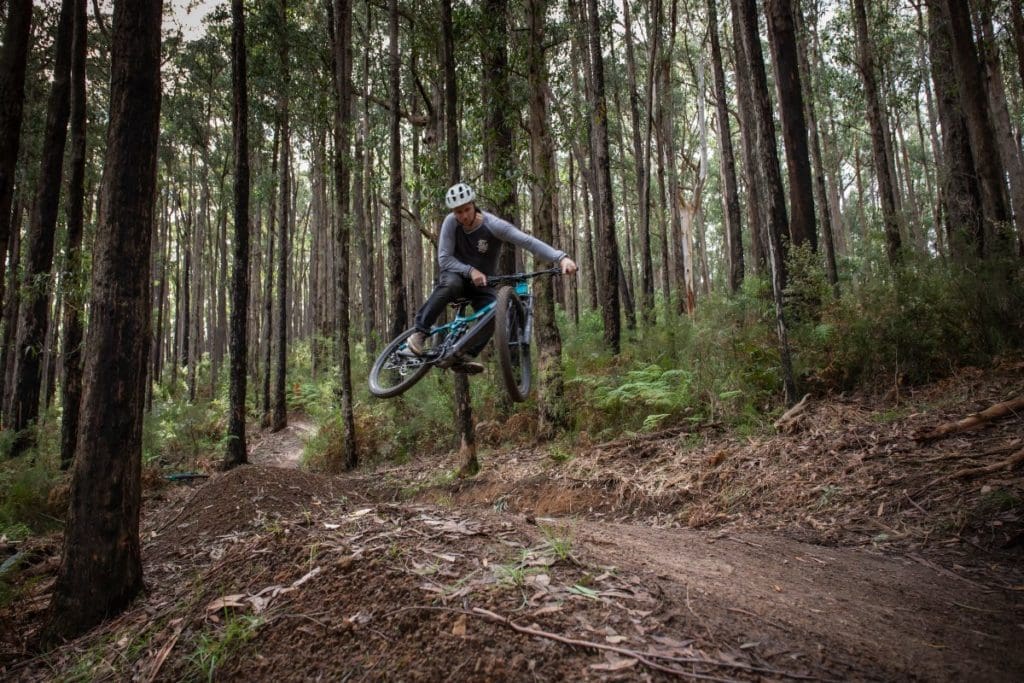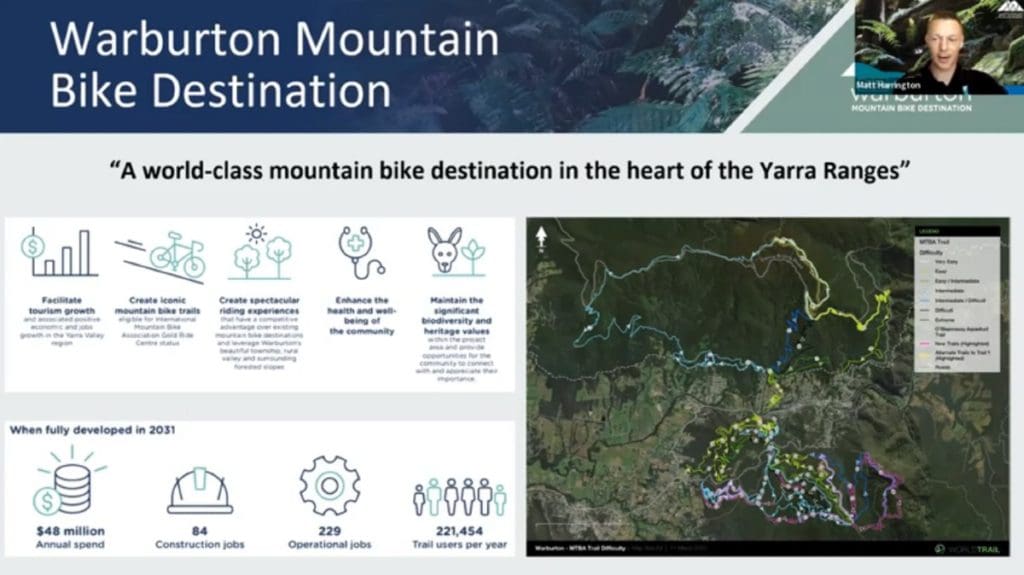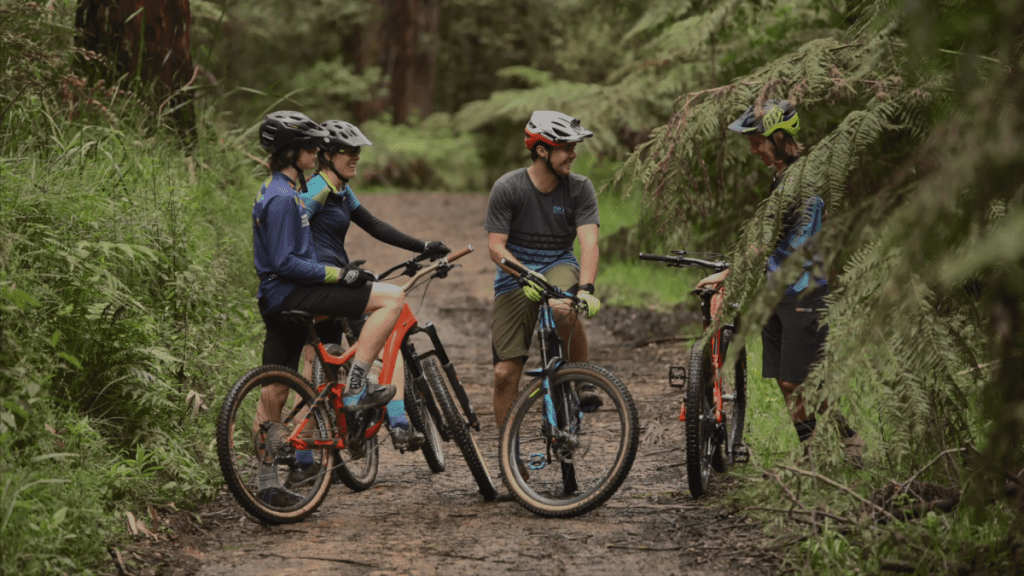Unprecedented Community Response to Warburton MTB Proposal

Warburton, Victoria
Thousands of public submissions have been received on a new Victorian mountain bike complex that is proposed to become Australia’s first ‘Gold-level’ facility and will set a new benchmark for MTB infrastructure in this country.
Around 2,700 submissions were received from community members and stakeholders during a public exhibition of an Environmental Effects Statement for the proposed Warburton Mountain Bike Destination in the Yarra Valley.
Yarra Ranges Council is hoping the facility will become one of only three Gold-level MTB complexes outside the US – with nearly 180km of trails set within scenic National Parks on Mt Donna Buang, Mt Little Joe and Mt Tugwell.
Its huge scale and location in highly valuable bushland has also ensured the project is breaking new ground in the levels of approval required.
“When people are looking to implement developments in National Park areas, the regulators are going to be looking at this site.”
Matt Harrington – Warburton Mountain Bike Destination
In May 2020, the State Minister for Planning, Richard Wynne, ruled the Warburton project would be the first mountain bike facility to require an Environmental Effects Statement under Victorian environmental protection laws.
The requirement has added nearly $4 million in costs and around two years in the approval process. People close to the project believe it is setting the new standard for approvals for future high-level MTB facilities in Australia.
“I think now when people are looking to implement developments in National Park areas, the regulators are going to be looking at this site and the rest of the country will need to take note,” Warburton Mountain Bike Destination’s executive project manager, Matt Harrington, said.
“The reality is no project of this nature has been through the process of an Environmental Effects Statement. They’re usually for massive road or farm projects, or similar developments.”
Matt said the heightened level of assessments, scrutiny and proposed monitoring is likely to become “the expectation” for cycling and walking projects in areas of high ecological value.”
The EES has required the developer, Yarra Ranges Council, to rigorously investigate possible ecological, social and economic impacts, as well as effects on cultural heritage, Aboriginal and European culture.
Full Picture
“But the benefit of this process is it has brought all aspects of the project together in an integrated way. It’s given us a full matrix of risks and values,” he said.
Submissions for the public exhibition closed on 25th January, and the project team has been combing through those comments in preparation for a panel enquiry that will complete the EES process.
We Ride Australia’s Director – National Advocacy, Stephen Hodge, said he believed the level of community response was unprecedented for a cycling issue in Australia.
“I’ve never heard of that number of submissions for anything to do with cycling, ever,” Stephen said.
The panel enquiry is scheduled to convene in March and is expected to take three to four weeks, depending on the number of expert witnesses called to address the hearing.
The panel’s recommendation will then be forwarded to the Minister, along with the council’s 3,500-page EES, for the Minister to make a final decision on whether the project can proceed.

“I have scanned all of the submissions and it’s overwhelmingly positive as far as the numbers go,” Matt said.
“That’s a real shift for projects that go through the EES process. They don’t usually get a positive level of feedback
“We have got an overwhelming number of comments that are positive but there are certainly some concerns. The facility is centred around a town of 2,000 people and some have fears about what’s going to happen to their little town, with parking etcetera.
“The demographic of Warburton is very diverse, with quite a performing arts component and a high number of holiday homes. For many years, it’s been a tourism destination.
“We are lucky there’s five large-scale accommodation development sites sitting vacant, with some of those projects worth tens of millions of dollars. We are getting backing from those investors, as they eagerly await a decision on the mountain bike project.”
The project team is hoping to have a decision and clear indication from the Minister by mid-2022 about if and how the complex will be able to proceed.
Encouraging Feedback
Matt said in addition to the overall tone of submissions, the project team was encouraged by the response and support of the Technical Reference Group formed to assist with the EES process.
“We will go to the panel enquiry with the confidence the EES has been overseen by a Technical Reference Group representing all the land managers and authorities,” he said.
“We’ve had experts out in the field and we’ve been able to demonstrate reasonable mitigation measures for the risks we have assessed.”
“You can build a booming track in a pine plantation but if you do it in a National Park you will get a much greater response and a much higher return.”
Matt Harrington – Warburton Mountain Bike Destination
The group has comprised Melbourne Water, Parks Victoria, the Department of Environment, Land, Water and Planning, and Wurundjeri Woi Wurrung Cultural Heritage Aboriginal Corporation.
The Aboriginal corporation has also been part of a broader Project Reference Group advising Yarra Ranges Council on the project.
Matt said as a result of the reference group’s investigations, and the EES studies in general, “there is likely to be adjustments to how we manage weeds, pest and pathogens but we are not making major changes to the designs for how we will build the trails, compared to where we started”.
“There will certainly be more checks and balances to ensure we do the things we say we’re going to do,” he added.
“There’s a much higher level of oversight and monitoring, at least in the short to medium term. For example, we will monitor water quality at crossings and if we don’t find a significant change in quality in the first couple of years, the frequency of monitoring is likely to scale back.
“It is the first mountain bike and walking trail development of this scale in Australia, so it will leave a legacy of protocols in place that government has approved.”
While this will put a lot of principles in place for other developers to follow, the increased assessments involved is still likely to bring higher costs for similar cycling and walking facilities.

Lessons for Regulators
He said fortunately for other projects, the Warburton venture should also be a good learning experience for regulators who typically deal with such large-scale developments.
“They don’t have a great deal of experience with mountain bike trails and what the potential impacts might be,” he explained.
“Regulators and decision makers need to understand the dynamics of mountain biking.
“The industry is not helping itself with the image it often likes to portray. When you open a mountain bike magazine, you see hero shots with big jumps and spraying dirt. That needs to be balanced by the fact that most people are most attracted by the opportunity to experience nature.”
Matt said the environmental component of the EES would be a particularly important test case for future high-end MTB ‘destinations’ in Australia because a high-value natural setting was essential for facilities aiming to become a national or international drawcard.
“The Derby facility in Tasmania is a classic example. People are attracted from all around the world because of the site. The visitors generally don’t talk about the jumps and berms, they talk about the natural environment,” he remarked.
“That’s where the high-value visitors come from. They spend more money, so there’s a greater return to the community.
“You can build a booming track in a pine plantation but if you do it in a National Park you will get a much greater response and a much higher return. Just changing the name of a park to a National Park will ensure it attracts a lot more interest because it’s a globally recognised brand.”
He said while Warburton complex’s ‘Drop-a-K’ trail will certainly be a centrepiece, with its 1000m vertical descent trail, the location’s natural landscapes, views and ability to immerse people in the outside natural environment will be its biggest attraction.
The multi-stage project, 70km east of Melbourne, is scheduled to be fully developed by 2031 and is expected to bring about 128,000 new visitors to the Yarra Ranges. It is estimated they will participate in 222,000 rides per year, and generate 77,000 overnight stays in the region annually.
“Township planning will be conducted alongside this project to maximise opportunities and ensure supporting services and infrastructure are in place,” according to the project website.
“The project would have a direct and positive impact on the local economy. It is expected to create 159 new local jobs and generate about $31.2 million in economic spend within the region each year.”
Plans for Stage 1 of the development include 110km of trail.
“Warburton has the potential to be in the top five for mountain bike destinations around the world. “
Matt Harrington – Warburton Mountain Bike Destination
“The mountain bike industry is definitely changing. If you look back at history, all projects have been user developments,” Matt said.
“$300,000 was seen as a big project. Now there have been more than $150 million worth of trails built in the past three or four years.
“Governments are taking a different approach. They are funding huge-scale projects, so there’s been more scrutiny.”
He said that scrutiny, and the legislation, was particularly strict in Victoria compared to other States, such as Queensland and WA.
However, Matt’s is cautiously optimistic the project team has been able to satisfy all the requirements.
“I think the outcome of the enquiry will be beneficial but we can’t really foretell what the Minister’s decision will be,” he said.
“I don’t think we have seen anything that will rule the project out and there’s nothing to suggest it won’t go ahead.
“If we don’t get approval, personally, I will probably curl up in a little ball and be non-responsive for a while. I’ve been involved since 2012, when working with Vic Parks on the project.”
Matt said the project team members have “put our hearts and souls into this project, to do everything possible to show the financial and other benefits will outweigh any impacts”.
“A lot of projects like this have been delivered around the world in a sustainable way, and we are taking things to that level with the environmental assessments and controls,” he added.
“Warburton has the potential to be in the top five for mountain bike destinations around the world.
“It’s a great example of going from a green site to being designed and constructed as a destination to bring people in from outside the area.
“In the end it’s a political decision being made by a politician. But we have had strong support from the community, and both MTB Victoria and Yarra Ranges Council strategies really identify the need for this facility to meet demand,” he said.
“If we don’t meet this emerging demand, then user-built trails will flourish. You don’t have any control over them and environmental and social damage will continue.
“That is a key point. The project started from a small group building trails without permission. They approached Vic Parks to tray and formalise that project and that process started many years ago.
“We now have less trails to ride than when the process began 10 years ago.”

Yarra Valley Rail Trail Network
The district is also home to one of Australia’s most popular rail-trails, with the 48km Lilydale to Warburton (Yarra Valley) Rail Trail, which attracts around 450,000 visits in 2020-21, although those numbers were boosted by a COVID spike. The trial previously attracted approximately 200,000 people annually.
In addition, work is underway on a substantial cycle and walking trail network that will link Lilydale, Yarra Glen, and Healesville, with plans to connect to the Lilydale-Warburton Rail Trail to create a valley-wide loop.
A new Yarra Valley Trail is using an existing rail corridor from Lilydale to Yarra Glen. The first stage, from Lilydale to Yering Station, has been completed and the section from Yering to Yarra Glen is scheduled to be finished in 2023.
Stage 1 is being built in partnership with the Federal Department of Infrastructure, Regional Development and Cities ($2.5 million contribution), the Victorian Government’s Growing Suburbs Fund ($2.5 million) and the Eastern Metro Partnerships ($1 million). Yarra Ranges Council has contributed $2.5 million to the project.
Stage 2 is proposed to connect to Healesville and Stage 3 will link back to the Lilydale -Warburton Trail in Woori Yallock. Stages 2 is in the design phase but not yet funded for construction, while Stage 3 is in the concept phase.
Join the Conversation:
Do you believe this is the future of major Australian MTB destinations?
